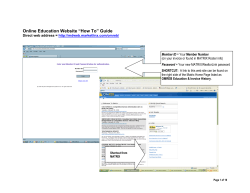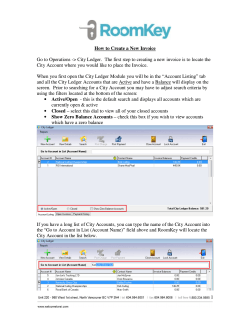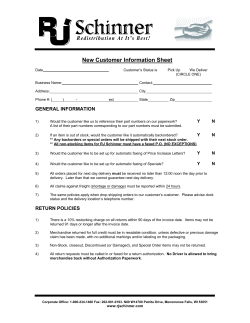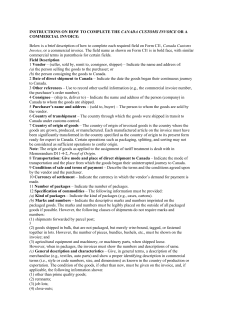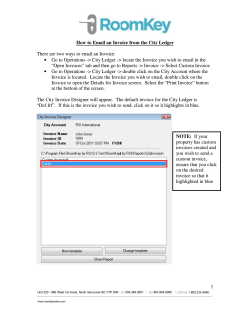
Business Process Modelling Marcello La Rosa -7.2/2012 - Queensland University of Technology
Business Process Modelling -7.2/2012 - Marcello La Rosa Queensland University of Technology Brisbane, 5 September 2013 Quick Repeat from Week 6 • What’s BPMN’s context and main goal? • What are the main differences between BPMN and EPCs? • How can we represent data objects and resources in a BPMN model? © INB/INN320 7.2/2013 – 5 September 2013 Assignment 1 common mistakes: Process Model Generally good quality models, but: • Missing labels on (X)OR-split conditions, message flows, start/end events • Two actions in one task (e.g. “Ship goods and invoice customer”) – decompose into 2 tasks instead • Too low level tasks such as “click X button” or “continue to X page on website” – aggregate when performed by same resource (e.g. “Fill out form”) • Normal sequence flow crossing pools’ boundaries © INB/INN320 7.2/2013 – 5 September 2013 Assignment 1 common mistakes: Process Model Modelling “without knowing”: • You are only required to use the elements we have explained before the deadline. If you venture yourself into advanced BPMN elements which we haven’t explained, you will still be marked if these are used improperly. • Our advice: don’t venture yourself into new stuff. © INB/INN320 7.2/2013 – 5 September 2013 Assignment 1 common mistakes: Format/Presentation Most marks lost in format/presentation: the textual documentation is meant to help understand the process models. Do not undervalue its importance and be diligent: • Refer to diagram labels in textual description, e.g. “Figure 1 below shows the high-level process model of xxx” • Use abbreviations consistently – BPM for Business Process Management, not for Business Process Modelling • Use professional language, do not shorten words: e.g. use “do not” instead of “don’t” • Present report structure succinctly in one paragraph in the Introduction before proceeding into core of report © INB/INN320 7.2/2013 – 5 September 2013 Assignment 1 common mistakes: Format/Presentation • Process models must be included in body of report, NOT in appendices: appendices only used to provide additional (i.e. non-core) information • Appendices need to be referenced in body of report • Concepts, benefits and challenges need explanation – do not assume readers know what you mean, e.g. “standardisation of notation”, “model-driven process execution” • Ensure process models are readable – it is ok to have one process model per page (vertical) instead of squeezing 3 models in one page • Significance of process modelling not stressed enough © INB/INN320 7.2/2013 – 5 September 2013 Agenda Today • • • • • • • • Organisation of this Subject Process Modelling Foundations of process modelling: Petri Nets Event-driven Process Chains (EPCs) Business Process Model and Notation (BPMN 2.0) Business Process Identification Business Process Discovery Methods Managing process modelling projects © INB/INN320 7.2/2013 – 5 September 2013 BPMN Modelling - Advanced Concepts (Part I) - How do we combine these? 1. What needs be done and when? - Control flow 2. What do we need to work on? – Data 3. Who’s doing the work? - Resources (human & non-human) Finance ERP Department Invoice Invoice received Enter Invoice Details Report Check Invoice Mismatches Invoice DB Invoice no Post Invoice mismatches Invoice posted Invoice Senior Finance Officer mismatch exists Block Invoice Invoice blocked © INB/INN320 7.2/2013 – 5 September 2013 Default flows • A default flow is the default branch to be chosen from an (X)OR-split if all other conditions evaluate to false • Avoids deadlocks if none of the conditions evaluates to true due to a modeller’s mistake • Is not necessarily the “most common choice” © INB/INN320 7.2/2013 – 5 September 2013 No mismatches Check Invoice for mismatches Mismatches that cannot be corrected Mismatches that can be corrected Post invoice Block invoice Correct mismatches Implicit vs. Explicit Control Flow Semantics A A C = B C B B = A C © INB/INN320 7.2/2013 – 5 September 2013 B A C What is this process doing? Party P&E Court Mail Processing Unit Sort Unopened Mail Collect Mail Daily rejection letter Registry Collected Mail document copy + receipt Sorted Unopened Mail Sort Opened Mail Mail Register Register Mail Check Mail Compliance Rejected Mailed Document Not acceptable Compile Mailed Document Requisition Mailed Document Requisition compiled Acceptable Sorted Mail Cashier Capture Mailed Document Matter Details Registered Mail Accepted Mailed Document Prepare Mailed Document Response Mailed Document Response prepared Physical File printed Document Copy + Receipt Receipt P&E Fee Payment Capture P&E Party Details Print Physical File Mailed Document Filed Document © INB/INN320 7.2/2013 – 5 September 2013 Captured Mailed Document Process Decomposition • An activity in a process can be decomposed into a “subprocess”. • Use this feature to: – Break down large models into smaller ones, making them easier to understand and to explain – Identify parts of a process model that should be: • • • • repeated executed multiple times in parallel cancelled, or compensated. Task © INB/INN320 7.2/2013 – 5 September 2013 Collapsed Sub-process Activities Expanded Sub-process Example: Sub-processes Process Invoice Process Payment Invoice received Process Invoice Enter Invoice / Credit Note Details no mismatches Check Invoice Mismatches mismatch exists © INB/INN320 7.2/2013 – 5 September 2013 Block Invoice Modelling process hierarchies with sub-processes Level 3 Process Inquiry and Quote Level 4 Receive and Validate Order Enter Order ... ... Check Credit Order received Level 5 Check Credit Record Credit available Credit not available Clear Order ... Contact customer account rep. (Fragment of the SCOR reference model) © INB/INN320 7.2/2013 – 5 September 2013 Identify possible sub-processes © INB/INN320 7.2/2013 – 5 September 2013 Solution © INB/INN320 7.2/2013 – 5 September 2013 The refactored model © INB/INN320 7.2/2013 – 5 September 2013 Question When should we decompose a process model into subprocesses? When the model becomes too large: – Hard to understand – Increased error probability Rule of thumb: no more than 30 flow objects (activities, events, gateways) © INB/INN320 7.2/2013 – 5 September 2013 Process Reuse By default, a sub-process is “embedded” into its parent process (i.e. it is stored within the same file) In order to maximize reuse, it is possible to “extract” the sub-process and store it as a separate file in the process model repository Such a sub-process is called “global” model, and is invoked via a “call” activity (represented with a thicker border) (normal) activity © INB/INN320 7.2/2013 – 5 September 2013 Call activity Example: process reuse Call activity is the default choice to maximize reusability © INB/INN320 7.2/2013 – 5 September 2013 Syntactical rules for sub-processes • Start with at least one start event – If multiple, first occurring will trigger the sub-process • Finish with at least one end event – The sub-process will complete once all tokens have reached an end event. May need an (X)OR-split after sub-process to understand what end event(s) have been reached • Sequence flows cannot cross sub-process boundaries – Use start/end events • Message flows can cross sub-process boundaries – To indicate messages emanating from/incoming into the subprocess © INB/INN320 7.2/2013 – 5 September 2013 Example: sub-process with multiple end events © INB/INN320 7.2/2013 – 5 September 2013 Arbitrary cycles • A cycle is a flow that goes back to an “earlier” point of the process. • Used to model parts of the process that can be repeated. Example: address ministerial correspondence The Finalise Ministerial Response sub-process includes the preparation of the Ministerial Response and the Review of the Response by the Principal Registrar. If the Registrar does not approve the Response, the latter needs to be prepared again for review. The process finishes only once the Response has been approved. XOR-join: entry point XOR-split: exit point Approved? Assign Ministerial Enquiry Receive Ministerial Enquiry © INB/INN320 7.2/2013 – 5 September 2013 Investigate Ministerial Enquiry Prepare Ministerial Response Review Ministerial Response Yes No Arbitrary cycles (cont’ed) • Arbitrary = unstructured, i.e. it can have multiple entry and exit points G entry point entry point A B C D E exit point F © INB/INN320 7.2/2013 – 5 September 2013 exit point Block-structured Repetition: Activity Loop • In WF-Nets and EPCs repetitions are captured via arbitrary cycles. • BPMN also provides the Activity Loop construct, which allows the repetition of a task or sub-process Task Loop Sub-process Loop • The main difference is that the Activity Loop is structured, while arbitrary cycles can be unstructured • Suggestion: use Activity Loop when your repetition is structured © INB/INN320 7.2/2013 – 5 September 2013 Example: block-structured repetition Until Response is approved Assign Ministerial Enquiry Finalise Ministerial Response Investigate Ministerial Enquiry Receive Ministerial Enquiry Finalise Ministerial Response Prepare Ministerial Response Enquiry investigated Review Ministerial Response Response reviewed Must have a decision activity © INB/INN320 7.2/2013 – 5 September 2013 Parallel Repetition: Multi-Instance activity • The multi-instance activity provides a mechanism to indicate that an activity is executed multiple times concurrently Multi-Instance Task Multi-Instance Sub-process • Useful when the same activity needs to be executed for multiple entities or data items, such as: – Request quotes from multiple suppliers – Check the availability for each line item in an order separately – Send and gather questionnaires for multiple witnesses in the context of an insurance claim © INB/INN320 7.2/2013 – 5 September 2013 Example: multi-instance activity In procurement, typically a quote is to be obtained from all preferred suppliers (assumption: five preferred suppliers exist). After all quotes are received, they are evaluated and the best quote is selected. A corresponding purchase order is then placed. © INB/INN320 7.2/2013 – 5 September 2013 Solution: without multi-instance activity Obtain Quote from Supplier A Obtain Quote from Supplier B ... Obtain Quote from Supplier C Obtain Quote from Supplier D Obtain Quote from Supplier E © INB/INN320 7.2/2013 – 5 September 2013 Select best quote Place PO ... Solution: with multi-instance activity cardinality For each supplier ... © INB/INN320 7.2/2013 – 5 September 2013 Obtain Quote Select best quote Place PO ... Example: multi-instance activity After a car accident, a statement is sought from the witnesses that were present, in order to lodge the insurance claim. As soon as the first two statements are received, the claim can be lodged to the insurance company without waiting for the other statements. PS: all people involved in the accident survived! © INB/INN320 7.2/2013 – 5 September 2013 Solution: multi-instance activity data collection denotes a set of data objects of the same type multi-instance pool denotes multiple participants of the same type completion condition indicates minimum number of instances required to complete (≤ cardinality) © INB/INN320 7.2/2013 – 5 September 2013 Uncontrolled Repetition: Ad-hoc sub-process • The ad-hoc sub-process contains activities (tasks or subprocesses) to be executed in arbitrary order and time • May define order of sub-set of activities by sequence flow • Can be used in an early version of a process diagram when the order of execution is still unknown • Denoted with a tilde marker Review company’s KPIs © INB/INN320 7.2/2013 – 5 September 2013 Evaluate prior performance Assess financial stability Profile products and services Interview corporate executives ~ Example: ad-hoc sub-process A typical army selection process starts by shortlisting all candidates’ applications. Those shortlisted are then called to sit the following tests: drug and alcohol, eye, color vision, hearing, blood, urine, weight, fingerprinting and doctor examination. The color vision can only be done after the eye test, while the doctor examination can only be done after color vision, hearing, blood, urine and weight have been tested. Moreover, it may be required for some candidates to repeat some of these tests multiple times in order to get a correct assessment, e.g. the blood test may need be repeated if the candidate has taken too much sugar in the previous 24 hours. The candidates that pass all tests are asked to sit a mental exam and a physical exam, followed by an interview. Only those that also pass these two exams and perform well in the interview can be recruited in the army. © INB/INN320 7.2/2013 – 5 September 2013 Solution: ad-hoc sub-process © INB/INN320 7.2/2013 – 5 September 2013 BPMN Poster: get it from blackboard! © INB/INN320 7.2/2013 – 5 September 2013 References Required • Sections 4.1 - 4.3.1 of Chapter 4 of textbook “Fundamentals of BPM” Recommended • OMG (2011): BPMN 2.0 Specification • BPM Offensive (2011): BPMN 2.0 Poster • OGM (2010): BPMN 2.0 By Example Web References • OMG BPM Initiative • BPMN Community Books on BPMN • Silver B. (2011): “BPMN Method & Style” 2nd Edition, Cody-Cassidy © INB/INN320 7.2/2013 – 5 September 2013 A/Prof. Marcello La Rosa BPM Discipline Information Systems School Science & Engineering Faculty Queensland University of Technology P block, GP campus Brisbane QLD 4000 Australia p +61 (0)7 3138-9482 e m.larosa@qut.edu.au w www.marcellolarosa.com © INB/INN320 7.2/2013 – 5 September 2013
© Copyright 2025

